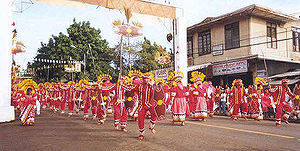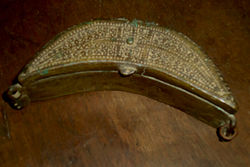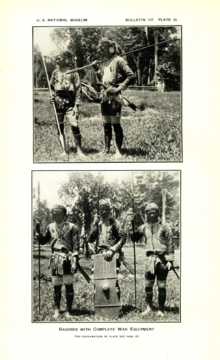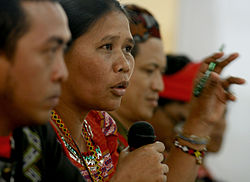- Lumad peoples
-
Lumad 
Total population Unknown Regions with significant populations  Philippines:
Philippines:
Caraga, Davao, Northern Mindanao, SOCCSKSARGEN, Zamboanga PeninsulaLanguages Several indigenous languages of Mindanao, Chabacano (in Zamboanga Region), Cebuano, Hiligaynon, Filipino language, English
Religion Christianity (Roman Catholic, Protestant) and Animist
Related ethnic groups Bajau, Moro, Visayan, other Filipino peoples, other Austronesian peoples
The Lumad is a term being used to denote a group of indigenous peoples of the southern Philippines. It is a Cebuano term meaning "native" or "indigenous". The term is short for Katawhang Lumad (literally "indigenous peoples"), the autonym officially adopted by the delegates of the Lumad Mindanaw Peoples Federation (LMPF) founding assembly on 26 June 1986 at the Guadalupe Formation Center, Balindog, Kidapawan, Cotabato, Philippines. It is the self-ascription and collective identity of the non-Islamized indigenous peoples of Mindanao.
Contents
History
See also: History of the Philippines (pre-1521)#Nesiots arrive 3000 BCThe name Lumad grew out of the political awakening among various tribes during the martial law regime of President Ferdinand Marcos. It was advocated and propagated by the members and affiliates of Lumad-Mindanao, a coalition of all-Lumad local and regional organizations which formalized themselves as such in June 1986 but started in 1983 as a multi-sectoral organization. Lumad-Mindanao’s main objective was to achieve self-determination for their member-tribes, or, put more concretely, self-governance within their ancestral domain in accordance with their culture and customary laws. No other Lumad organization had had the express goal in the past.
Representative from fifteen tribes agreed in June 1986 to adopt the name; there were no delegates from the Three major groups of the T'boli, the Teduray and the Subanen. The choice of a Cebuano word was a bit ironic but they deemed it to be most appropriate considering that the various Lumad tribes do not have any other common language except Cebuano. This is the first time that these tribes have agreed to a common name for themselves, distinct from that of the Moros and different from the migrant majority and their descendants.
People
There are 18 Lumad ethnolinguistic groups namely, Atta, Bagobo, Banwaon, B’laan, Bukidnon, Dibabawon, Higaonon, Mamanwa, Mandaya, Manguwangan, Manobo, Mansaka, Subanon, Tagakaolo, Tasaday, Tboli, Teduray, and Ubo.
According to the Lumad Development Center Inc., there are about eighteen Lumad groups in 19 provinces across the country. They comprise 12 to 13 million or 18% of the Philippine population and can be divided into 110 ethno-linguistic groups. Considered as "vulnerable groups", they live in hinterlands, forests, lowlands and coastal areas.[1]
Katawhang Lumad are the un-Islamized and un-Christianized Austronesian peoples of Mindanao, namely Erumanen ne Menuvu`, Matidsalug Manobo, Agusanon Manobo, Dulangan Manobo, Dabaw Manobo,Ata Manobo, B'laan, Kaulo, Banwaon, Teduray, Lambangian, Subanen, Higaunon, Dibabawon, Mangguwangan, Mansaka, Mandaya, K'lagan, T'boli, Mamanuwa, Talaandig, Tagabawa, and Ubu`, Tinenanen, Kuwemanen, K'lata and Diyangan. There are about twenty general hilltribes of Mindanao, all of which are Austronesian.
The term Lumad excludes the Butuanons and Surigaonons--even the said two ethnic groups are native to Mindanao and the word tells it so—because those two are Visayans and Lumad are not ethnically related to them, which creates a contradiction because the word lumad literally means "native" in Visayan.
B'laan
The B'laan is an indigenous group that is concentrated in Davao del Sur and South Cotabato. They practice indigenous rituals while adapting to the way of life of modern Filipinos.[2]
Bukidnon
The Bukidnon are one of the seven tribes in the Bukidnon plateau of Mindanao. Bukidnon means 'that of the mountains' (i.e. 'people of the mountains'), despite the fact that most Bukidnon tribes settle in the lowlands. The name Bukidnon is itself used to describe the entire province in a different context (it means 'mountainous lands' in this case).[3]
The Bukidnon people believe in one god, Magbabaya (Ruler of All), though there are several minor gods and goddesses that they worship as well. Religious rites are presided by a baylan whose ordination is voluntary and may come from both sexes. The Bukidnons have rich musical and oral traditions[4] which are celebrated annually in Malaybalay City's Kaamulan Festival, along with other tribes in Bukidnon (the Manobo tribes, the Higaonon, Matigsalug, Talaandig, Umayamnom, and the Tigwahanon).[5]
Kaulo
Kaulo (also spelled Kaolo or Kaulu) or Tagakaulo is one of the tribes in Mindanao. Their traditional territories is in Davao Del Sur and the Sarangani Province particularly in the localities of Malalag, Lais, Talaguton Rivers, Sta. Maria, and Malita of Davao del Sur, and Malungon of the Sarangani Province. Kaulo means 'People of the Mountain Tops', from the words Ka- (people) and Ulo (top or head). The Kaulo tribe originally came from the western shores of the gulf of Davao and south of Mt. Apo.[6] a long time ago.
Manobo
Manobo is the hispanized spelling of Manuvu (since there is no difference between the pronunciation of orthographic ‹b› and ‹v› in Castilian Spanish, the /v/ sound was lost when translated to Spanish). Its etymology is unclear but in its current form it means 'person' or 'people'.
The Manobo are probably the most numerous of the ethnic groups of the Philippines in terms of the relationships and names of the various groups that belong to this family of languages. Mention has been made of the numerous subgroups that comprise the Manobo group. The total national population including the subgroups is 749,042 (NM 1994); occupying core areas from Sarangani island into the Mindanao mainland in the provinces of Agusan del Sur, Davao provinces, Bukidnon, and North and South Cotabato. The groups occupy such a wide area of distribution that localized groups have assumed the character of distinctiveness as a separate ethnic grouping such as the Bagobo or the Higaonon, and the Atta. Depending on specific linguistic points of view, the membership of a dialect with a supergroup shifts.[7]
Subanon
Main article: SubanonThe Subanons are the first settlers of the Zamboanga peninsula.The family is patriarchal while the village is led by a chief called Timuay. He acts as the village judge and is concerned with all communal matters.History has better words to speak for Misamis Occidental. Its principal city was originally populated by the Subanon, a cultural group that once roamed the seas in great number, the province was an easy prey to the marauding sea pirates of Lanao whose habit was to stage lightning forays along the coastal areas in search of slaves. As the Subanon retreated deeper and deeper into the interior, the coastal areas became home to inhabitants from Bukidnon who were steadily followed by settlers from nearby Cebu and Bohol.
The name Subanon means 'People of the riverside', coming from the root word Subâ ('creek' or 'river')[8]
Higaonon
The Higaonon is located on the provinces of Bukidnon, Agusan del Sur, Misamis Oriental, Rogongon, Iligan City, and Lanao del Norte. Their name means "people of the wilderness". Most Higaonons still have a rather traditional way of living. Farming is the most important economic activity.
Mamanwa
The Mamanwa is a Negrito tribe often grouped together with the Lumad. They come from Leyte, Agusan del Norte, and Surigao provinces in Mindanao. Primarily in Kitcharao and Santiago, Agusan del Norte,[9] though they are lesser in number and more scattered and nomadic than the Manobos and Mandaya tribes who also inhabit the region. Like all Negritos, the Mamanwas are genetically distinct from the lowlanders and the upland living Manobos, exhibiting curly hair and much darker skin tones.
The political system of the Mamanwas is informally democratic and age-structured. Elders are respected and are expected to maintain peace and order within the tribe. The chieftain, called a Tambayon, usually takes over the duties of counselling tribal members, speaking at gatherings, and arbitrating disagreements. They believe in a collection of spirits, which are governed by the supreme deity Magbabaya. The tribe produce excellent winnowing baskets, rattan hammocks, and other household containers.
Mamanwa (also spelled Mamanoa) means 'first forest dwellers', from the words man (first) and banwa (forest).[10] They speak the Mamanwa language (or Minamanwa).[11]
Mandaya
"Mandaya" derives from "man" meaning "first," and "daya" meaning "upstream" or "upper portion of a river," and therefore means "the first people upstream". It refers to a number of groups found along the mountain ranges of Davao Oriental, as well as to their customs, language, and beliefs. The Mandaya are also found in Compostela and New Bataan in Compostela (formerly a part of Davao del Norte Province).
Mansaka
The term "Mansaka" derives from "mang" with literal meaning "to" and "saka" meaning "climb," and means "to climb or to ascend mountains/upstream." The term most likely describes the origin of these people who are found today in Davao del Norte and Davao del Sur. Specifically in the Batoto River, the Manat Valley, Caragan, Maragusan, the Hijo River Valley, and the seacoasts of Kingking, Maco, Kwambog, Hijo, Tagum, Libuganon, Tuganay, Ising, and Panabo.[12]
Sangil
The Sangir or Sangil is located in the islands of Balut, Sarangani, and the coastal areas of South Cotabato and Davao del Sur. Their name comes from Sangihe, an archipelago located between Sulawesi and Mindanao. This was their original home but they migrated northwards.
Tagabawa
Tagabawa is the language used by the Bagobo-Tagabawa. They are the indigenous tribe in Mindanao. They live in the surrounding areas of Mt. Apo.[13]
Tasaday
The Tasadays are a group of about two dozen people living within the deep and mountainous rainforests of Mindanao, they attracted wide media attention in 1971 when they were first "discovered" by western Scientists who thought reported that they were living at a "stone age" level of technology and had been completely isolated from the rest of Philippine society. They later attracted attention in the 1980s when it was reported that their discovery had in fact been an elaborate hoax, and doubt was raised both about their status as isolated from other societies and even about the reality of their existence as a separate ethnic group. The question of to which degree the Tasaday evidence published in the seventies reflect reality is still being discussed.[14][15]
T'boli
Main article: TboliThe Tbolis are one of the indigenous peoples of South Mindanao. From the body of ethnographic and linguistic literature on Mindanao they are variously known as Toboli, T'boli, Tböli, Tiboli, Tibole, Tagabili, Tagabeli, and Tagabulu. They term themselves Tboli or T'boli. Their whereabouts and identity is to some extend confused in the literature; some publications present the Toboli and the Tagabili as distinct peoples; some locate the Tbolis to the vicinity of the Buluan Lake in the Cotabato Basin or in Agusan del Norte. The Tbolis, then, reside on the mountain slopes on either side of the upper Alah Valley and the coastal area of Maitum, Maasim and Kiamba. In former times, the Tbolis also inhabited the upper Alah Valley floor.
Musical heritage
Most of the Mindanao Lumad groups have a musical heritage consisting of various types of Agung ensembles – ensembles composed of large hanging, suspended or held, bossed/knobbed gongs which act as drone without any accompanying melodic instrument.[16]
Social issues
At the beginning of the 20th century, the Lumads controlled an area which now covers 17 of Mindanao’s 24 provinces, but by the 1980 census they constituted less than 6% of the population of Mindanao and Sulu. Heavy migration to Mindanao of Visayans, spurred by government-sponsored resettlement programmes, turned the Lumads into minorities. The Bukidnon province population grew from 63,470 in 1948 to 194,368 in 1960 and 414,762 in 1970, with the proportion of indigenous Bukidnons falling from 64% to 33% to 14%.
Lumads have a traditional concept of land ownership based on what their communities consider their ancestral territories. The historian B. R. Rodil notes that ‘a territory occupied by a community is a communal private property, and community members have the right of usufruct to any piece of unoccupied land within the communal territory.’ Ancestral lands include cultivated land as well as hunting grounds, rivers, forests, uncultivated land and the mineral resources below the land.
Unlike the Moros, the Lumad groups never formed a revolutionary group to unite them in armed struggle against the Philippine government. When the migrants came, many Lumad groups retreated into the mountains and forests. However, the Moro armed groups and the Communist-led New People’s Army (NPA) have recruited Lumads to their ranks, and the armed forces have also recruited them into paramilitary organisations to fight the Moros or the NPA.
For the Lumad, securing their rights to ancestral domain is as urgent as the Moros’ quest for self-determination. However, much of their land has already been registered in the name of multinational corporations, logging companies and other wealthy Filipinos, many of whom are, relatively speaking, recent settlers to Mindanao. Mai Tuan, a T'boli leader explains, “Now that there is a peace agreement for the MNLF, we are happy because we are given food assistance like rice … we also feel sad because we no longer have the pots to cook it with. We no longer have control over our ancestral lands.”[17]
See also
- Ethnic groups in the Philippines
- Indigenous peoples of the Philippines
- Negrito
- Manobo languages
- Filipino people
- Moro people
References
- ^ Date: 31 October 2006, Kidapawan City, Philippines. Contributed by: Pependayan, LMPF Secretary General from 1988–1999
- ^ B’laan women record dreams in woven mats – INQUIRER.net, Philippine News for Filipinos
- ^ Bukidnon by Filipino Santos
- ^ Bukidnon heritage kept alive, Dr. Antonio Montalvan II", inq7.net (accessed through seasite.niu.edu on 3 February 2010)
- ^ Kaamulan Festival", Bukidnon.gov (accessed 3 February 2010)
- ^ http://litera1no4.tripod.com/tagakaolo_frame.html
- ^ http://litera1no4.tripod.com/manobo_frame.html
- ^ Who Are The Native Zamboanguenos
- ^ Anthropology Museum: Mamanwa
- ^ Mamanwa
- ^ Ethnologue Report: Mamanwa Language
- ^ Fuentes, Vilma May A.; De La Cruz, Edito T. (1980). A Treasure of Mandaya and Mansaka Folk Literature. Quezon City, Philippines: New Day Publishers. p. 2.
- ^ http://www.joshuaproject.net/people-profile.php?rop3=109689&rog3=RP Joshua Project – Bagobo, Tagabawa of Philippines Ethnic Profile
- ^ Shaping and Reshaping the Tasaday: A Question of Cultural Identity—A Review Article, AA Yengoyan – The Journal of Asian Studies, 1991
- ^ Invented Eden: The Elusive, Disputed History of the Tasaday, Robin Hemley. U of Nebraska Press, 2007
- ^ Mercurio, Philip Dominguez (2006). "Traditional Music of the Southern Philippines". PnoyAndTheCity: A center for Kulintang – A home for Pasikings. http://www.pnoyandthecity.blogspot.com. Retrieved 25 February 2006.
- ^ Mindanao, Land of Promise
External links
- Portraits of Lumad People
- Preserving Culture: the Tboli of Mindanao
- The indigenous people of Mindanao
- The indigenous people of Central and Eastern Mindanao
Lumad peoples 
Indigenous peoples of the Philippines 
National Commission on Indigenous Peoples of the Philippines Categories:
Wikimedia Foundation. 2010.





